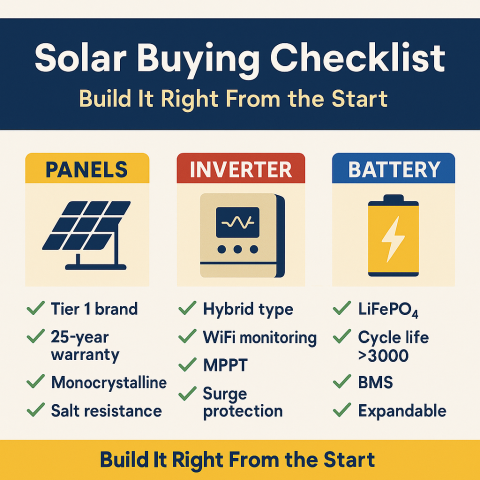What to Look for When Buying Solar Panels, Inverters, and Batteries
What to Look for When Choosing Solar Panels, Inverters, and Battery Systems
A solar setup is only as good as the components and workmanship behind it. Below are the key technical and practical criteria that ensure your system is efficient, durable, and safe.
Solar Panels – What Matters Most
Module Type:
Monocrystalline: Best efficiency, especially in small roof areas
Polycrystalline: Cheaper, but needs more space
Thin-film: Avoid for rooftops in the tropics – too low yield
Power Rating:
Choose 450–600 W panels for modern systems – fewer panels needed for same output
Warranty:
25 years on power output (80–85 % retention)
10–15 years on materials and workmanship
Brand Quality:
Stick to Tier 1 manufacturers like:
JA Solar
Trina Solar
Jinko
REC Solar
Canadian Solar
Anti-PID + Salt Mist Resistant Coating
Tropical humidity + sea air can degrade cheap panels. Ask for IEC 61701 certification.
Inverter – The Brain of the System
Type:
Choose hybrid inverter if you want both grid connection and battery support
Efficiency:
Look for >97% conversion efficiency (DC to AC)
MPPT Inputs:
More MPPTs = more flexible panel layout (useful for different roof angles or partial shading)
Brand examples:
Solis
Growatt
SMA
Huawei
Fronius
Monitoring Capability:
WiFi-enabled systems with app/web interface are ideal for tracking power use and faults
Surge Protection & Islanding Function:
Prevents damage and improves safety during brownouts or lightning
Battery – If You Include One
Chemistrie:
LiFePO₄ (Lithium Iron Phosphate) preferred for home use: safe, long cycle life
Avoid traditional lead-acid unless budget-limited (shorter lifespan, heavier, less efficient)
Capacity:
Choose based on evening + nighttime use – typically 5–10 kWh for a small home
Cycle life:
Aim for 3000–6000 full cycles (8–12 years average daily use)
BMS (Battery Management System):
Prevents overcharging, overheating, and unbalanced cells
Expandable:
Choose brands that allow you to add more batteries later
Installation and Workmanship
Certified Installer:
Only use licensed solar technicians – improper wiring = fire risk
Proper Breakers & Fuses:
DC breakers, surge arresters, grounding – don’t skimp on safety
Conduit & Cable Quality:
Use UV-resistant cables with correct sizing – oversized is better than undersized
Panel Angle & Orientation:
Optimal in the Philippines: 10–15° tilt, facing south or southwest, avoid afternoon shading
Roof Load Assessment:
Light metal roofs (yero) may need reinforcement – especially for typhoon-prone areas
Summary: Checkpoints Before Buying a Solar System
Component Check for
PanelsTier-1 brand, 25-year warranty, monocrystalline, salt resistance
InverterHybrid, WiFi monitoring, MPPT, surge protection
BatteryLiFePO₄, cycle life >3000, BMS, expandable
InstallerLicensed, with references and full warrantyElectricalProper wiring, breakers, grounding, neat & safe layout
Autor: Nils Deden


Comments
There are no comments yet